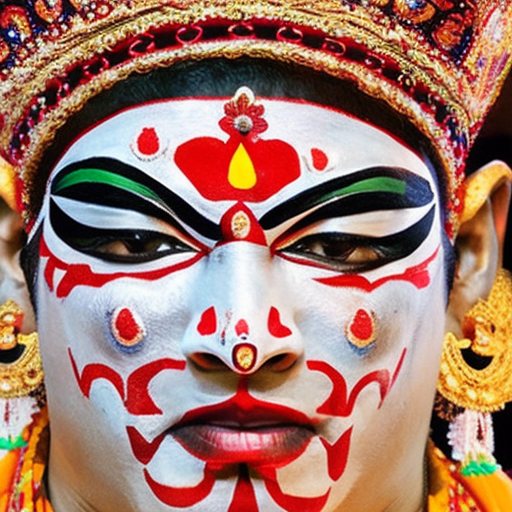Kathakali: A Traditional Dance-Drama of Kerala
Kathakali is a highly stylized form of classical Indian dance-drama that originated in the state of Kerala. It combines elements of dance, music, and acting to tell stories from Hindu mythology. Kathakali is known for its elaborate costumes, intricate makeup, and expressive gestures, making it a visually stunning and emotionally powerful art form.
The Origins and Evolution of Kathakali
Kathakali has its roots in ancient Sanskrit drama and traditional dance forms of Kerala. It emerged as a distinct art form in the 17th century, during the reign of the King of Travancore, Raja Martanda Varma. The king played a significant role in the development and patronage of Kathakali, encouraging the training of artists and the establishment of dedicated performance spaces.
Over the centuries, Kathakali has evolved and incorporated elements from various dance and theater traditions. It draws inspiration from the ancient Indian texts of Natyashastra and Abhinaya Darpana, which provide guidelines for the art of expression and gesture. Kathakali also incorporates elements of martial arts and folk dances, adding dynamism and vigor to its performances.
The Elements of Kathakali
Kathakali is characterized by its unique combination of dance, music, and acting. The performers, known as “artists,” undergo rigorous training in all these aspects to master the art form.
1. Makeup and Costume: One of the most striking features of Kathakali is its elaborate makeup and costumes. The artists spend hours applying makeup, which involves intricate designs and vibrant colors to represent different characters. The costumes are equally elaborate, with ornate headgear, flowing skirts, and jewelry.
2. Mudras and Gestures: Kathakali relies heavily on hand gestures, known as mudras, to convey emotions and tell stories. Each mudra has a specific meaning and is used in combination with facial expressions and body movements to create a rich visual language.
3. Music and Instruments: The music in Kathakali plays a crucial role in setting the mood and enhancing the dramatic impact. It is accompanied by a variety of instruments, including drums, cymbals, and the unique chenda, a cylindrical percussion instrument. The singers, known as “sopanam,” sing in a distinct style that complements the movements and emotions of the performers.
4. Narration and Acting: Kathakali performances are usually based on stories from Hindu epics like the Ramayana and Mahabharata. The artists use a combination of dance, music, and acting to bring these stories to life. They employ exaggerated facial expressions, body movements, and vocal techniques to portray various characters and emotions.
The Significance and Impact of Kathakali
Kathakali holds great cultural and religious significance in Kerala. It is considered a sacred art form and is often performed in temples and during religious festivals. The stories depicted in Kathakali reflect the rich mythology and cultural heritage of India, providing a link to the country’s ancient traditions.
Kathakali has also gained international recognition and has been performed in various countries around the world. Its visually captivating performances and powerful storytelling have captivated audiences and influenced artists in different disciplines. The art form has inspired filmmakers, choreographers, and theater directors, who have incorporated elements of Kathakali into their works.
In conclusion, Kathakali is a unique dance-drama that combines dance, music, and acting to tell stories from Hindu mythology. Its elaborate costumes, intricate makeup, and expressive gestures make it a visually stunning and emotionally powerful art form. Kathakali holds great cultural and religious significance in Kerala and has had a significant impact on the world of performing arts.












